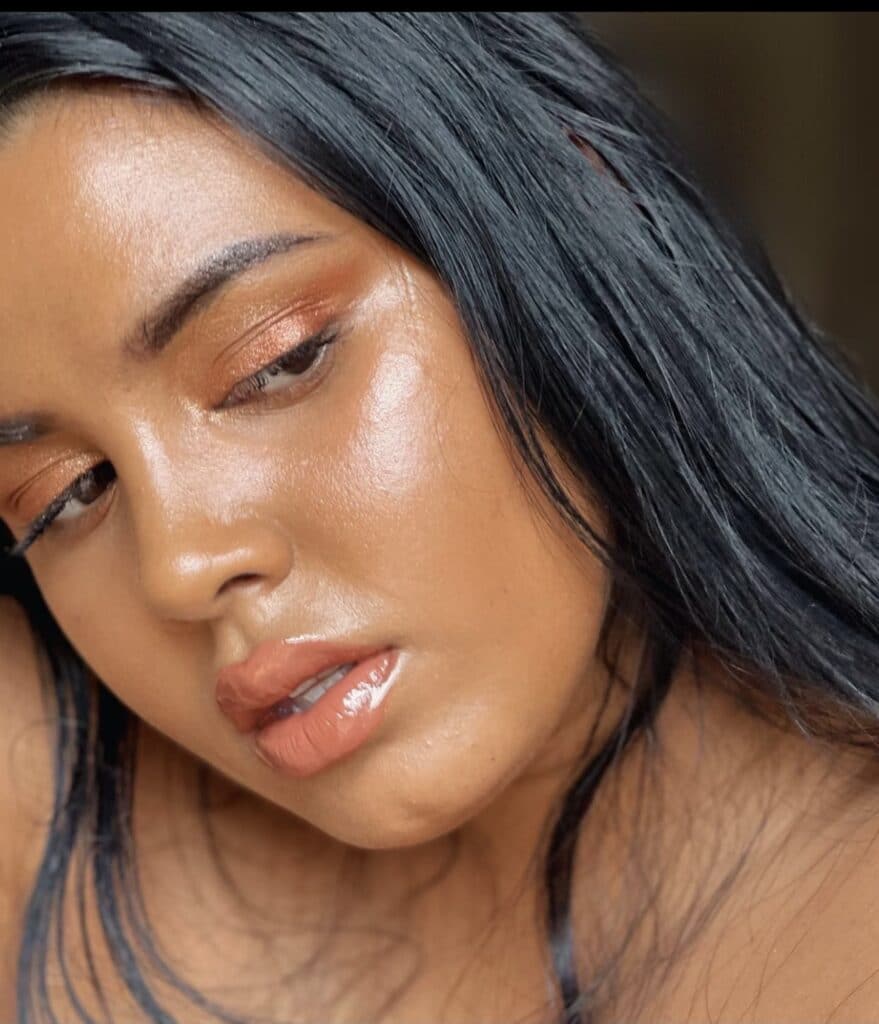
Faces of Australia is a column highlighting BIPOC creatives to bring you their stories. Creators are asked to collaborate on a makeup look that empowers, holds meaning, or describes their experience as it relates to Australian beauty standards and the Australian beauty industry. Faces of Australia is written and produced by Ruchi Page, with a mission to show the beauty industry how accessible BIPOC talent is across this diverse nation.
Episode 6: Fallon Gregory
The brief? The power of melanin.
I bring you the brilliant Fallon Gregory. Fallon is an Indigenous Australian beauty content creator who paved her own way to establish a platform on educating her followers about the significance of her heritage. Our makeup look is inspired by the power of our skin, focusing on our complexions to showcase the beauty of melanin, which has been the driving force of our most memorable life experiences. On that note, I chatted with the creator to understand the beauty world from the lens of an Indigenous Australian woman. Here is what I learned.

Fallon and I explored what shaped her identity and upon reflection, she tells me it’s her children, heritage, upbringing, and family’s influence. In-tune with nature, the creative makes time for all that our country has to offer, whether that’s a quick trip to the beach or fuelling herself with exercise. Whilst Fallon experiences a sense of belonging within her family, life outside her home has failed to match the same acceptance.
Fallon will be the first Indigenous Australian voice and perspective we will hear from in this series. When I asked about her experiences within the beauty industry, Fallon was unable to recall a single moment where she felt represented. “Growing up, there weren’t any WOC, let alone Indigenous Australian women included in the standard of beauty in mainstream Australian media,” she tells me.
The 28-year-old insists that Australia still has a long way to go. We chatted about the luxury of being catered to within mainstream beauty spaces, and neither Fallon nor myself could relate to feeling welcomed when it came to getting our makeup done for a special event or in Fallon’s case, going to a modeling job, only to be met with confusion. We soon established there was a solid lack of understanding and willingness to learn about cosmetic needs for the BIPOC community.

As our conversation deepened, I wanted to unravel the moment where Fallon clocked the beauty industry’s need for change— the moment that sparked her strength to declare the need to belong. It was clear to both of us that the Black Lives Matter movement charged into Australia with impact and triumph, as brands began to seemingly and swiftly change their approach to advertising. Fallon reinforced this conversation by reminding us that “the Black Lives Matter movement saw a horde of brands and labels scrambling to diversify their image, leaving us all wondering what exactly they had in place beforehand as BIPOC representation.”
So what was in place beforehand? A traditional standard of beauty that reflected one type of set colour and features. A standard that people like Fallon and myself could never relate to.
The content creator acknowledges the obvious growth in opportunities that emerged for BIPOC post-June 2020. But Fallon notes the performative action that lies beneath so many of these initiatives. “To support people of colour means to continue that support,” she says. Fallon recalls conversations and personal experiences where BIPOC individuals have felt “cheated and disposable.” An incredibly damaging outcome from a seemingly positive movement. Fallon details the disappointment she felt when brands approached her with jobs and partnerships to align with the movement, only to discover these opportunities were either unpaid or a ‘one-off’ feature.
As the initial hype of Black Lives Matter faded, Fallon recalls opportunities to collaborate with beauty brands quickly faded and in many instances, the Perth-based blogger was left on ‘seen’ or rejected when discussing further opportunities. We recognised that whilst some brands may want to work with an array of BIPOC creators rather than just one on a repetitive basis, there was absolutely a mass shift back to old habits as soon as BLM coverage was no longer at the forefront.
Fallon wishes to remind brands that “the tokenism is very evident once you become aware. And to put us in a job because a brand/label/business needs to tick a diversity box over providing genuine support of BIPOC, is not only extremely transparent but pathetic.” It’s important to note that these gaps in the industry are a reminder of the strenuous efforts the BIPOC community must go through to achieve basic equal treatment.
Our conversation concludes with Fallon’s final thoughts on the Australian beauty industry as an Indigenous Australian:
“There have been baby steps to inclusion, but we still have a very long way to go. Why are we not the standard of beauty in a country we’re Indigenous to? If the beauty standards set upon Australia aren’t inclusive of First Nations people, it is foreign. When I look at large Australian campaigns that don’t include First Nations women, that’s how I feel. We need to see the implementation of Indigenous Australian people first, not as an afterthought or not a thought at all. We are no longer accepting crumbs at the table.”
– Fallon Gregory, model and beauty content creator
PRODUCTS USED







